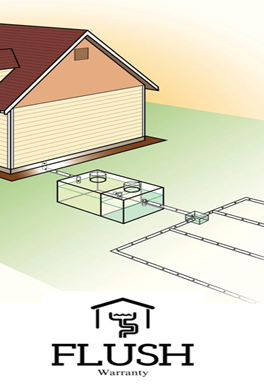
How to keep your budget on track and your toilets flushing!
Septic systems are out of sight and out of mind. Most people don’t think about the condition of their septic system unless they are selling their home, or an issue arises. Typical time-of-property-transfer septic inspections only provide information at one point in time and can only raise red flags about the short-term future performance and reliability of an onsite system. When your septic system fails, you can’t flush your toilets, take a shower, or even do a load of laundry and unlike your roof, where you can physically see the deterioration, you won’t know your septic has failed until it is too late. A common mistake that homeowners make is forgetting that their septic system is a crucial component of their home, requiring routine maintenance and care.
Understanding how a Septic System works is essential to keeping your system functioning.
- All water runs out of your house from one main drainage pipe into a septic tank.
- The septic tank is a buried, water-tight container usually made of concrete, fiberglass, or polyethylene. Its job is to hold the wastewater long enough to allow solids to settle down to the bottom, forming sludge, while the oil and grease float to the top as scum.
- The liquid wastewater (effluent) then exits the tank into the drain field.
- Pretreated wastewater is discharged through piping that allows wastewater to filter through the soil. The soil accepts, treats, and disperses wastewater as it percolates through the soil.
If the drain field is overloaded with too much liquid, it can flood, causing sewage to flow to the ground surface or create backups in toilets and sinks.
Be Proactive, use these tips and tricks to keep your system up and running:
Maintenance: Septic tanks should be pumped out every 2-4 years to remove the solids that collect inside of your septic tank. Cleaning schedules vary based on the number of occupants in a home, the food you eat, and system size. Therefore, you must consult with a septic technician to determine your proper cleaning schedule.
Just because you don’t see it anymore doesn’t mean it goes away. Here is a list of “Don’ts” to protect your system:
Grease: Do not poor any grease or oils down your drains. Grease can clog pipes and impact the chemistry of the whole septic tank and system. We recommend pouring your cooking grease into a container and throwing it into your garbage once it hardens.
Wipes: Even if they say they are flushable, they are not. Baby wipes are much thicker than typical toilet paper. Therefore, they do not adequately break down to form sludge, and they cause your scum layer to build up much quicker forcing it out into your drain fields. We recommend placing a garbage can next to your toilet to dispose of baby wipes.
Garbage disposals: They are designed to remove small food particles that stick to your plate. If you have one in your home, do not use it as another garbage source. Instead, we recommended scraping your plate in your garbage can before rinsing it into the sink.
Water softeners: Softeners discharging into the septic disturbs the scum layer at the top of the tank, causing more solids to go out into the leach field. The salty brine impacts the soil’s permeability, causing a slow-flowing drain field and corroding the concrete in the septic tank. It is essential to consult with your septic company to see if your water softener discharges into the septic.
Don’t wait to call: Slow running toilets, wet spots in the lawn, or septic odors are told tail signs of an issue with your septic system. It is crucial to call a septic technician if any symptoms appear to avoid costly bills and septic backups.
Questions with your septic? No questions are a bad one, and we would love to hear from you! Contact us today:
Nicholas AndersonAnderson Brothers Sanitation/FLUSH Warranty203-421-4080 – Nicholas.anderson@flushwarranty.comService area: Branford-Old Saybrook